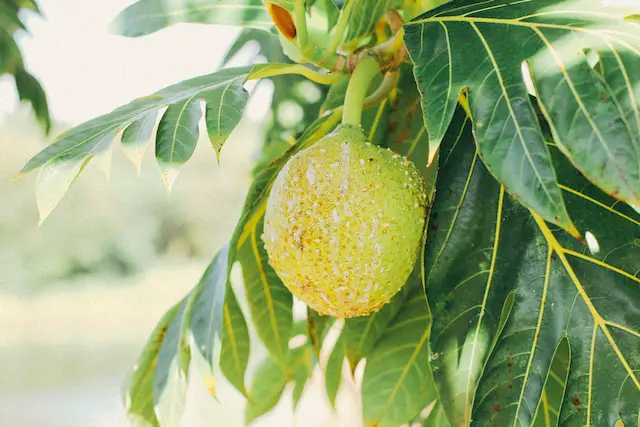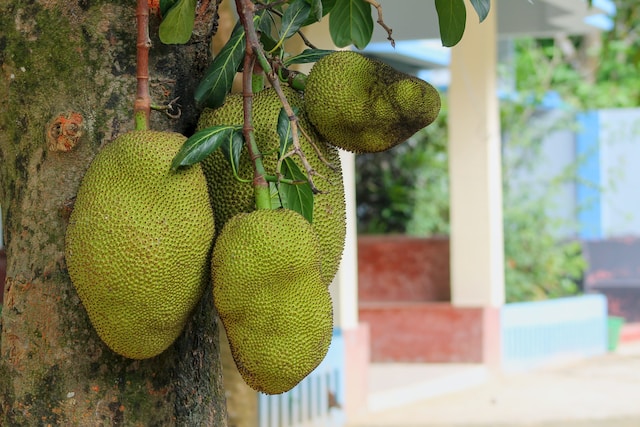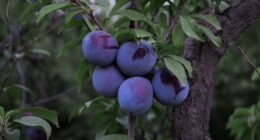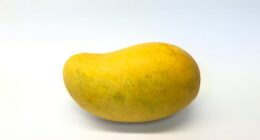Breadfruit and jackfruit are both tropical fruits, but they differ in appearance, flavor, texture, nutritional content, and culinary uses. Breadfruit has a mild flavor and starchy texture and is often used as a potato or rice substitute, while jackfruit has a sweet, tropical flavor and a fibrous, meat-like texture and is often used as a meat substitute in vegan and vegetarian dishes.
Breadfruit
(Photo by Studio Kealaula on Unsplash )

Breadfruit is a tropical fruit that is native to the South Pacific and Caribbean regions. It is a member of the mulberry family and is closely related to jackfruit and figs. Breadfruit is a starchy fruit that is often used as a staple food in tropical countries, as it is a good source of carbohydrates and other nutrients. It is also used in a variety of dishes, such as stews, curries, and soups. The fruit can be cooked in many ways, including boiling, baking, or frying, and has a texture similar to that of potatoes or bread.
Jackfruit
(Photo by Antonio Castellano on Unsplash )

Jackfruit is a tropical fruit that is native to Southeast Asia and India. It is the largest tree-borne fruit in the world and can weigh up to 80 pounds. Jackfruit has a spiky, greenish-yellow skin and a bright yellow, fibrous flesh. When ripe, it has a sweet, tropical flavor and a strong aroma. Jackfruit is often used as a meat substitute in vegan and vegetarian dishes due to its meaty texture and ability to take on flavors and spices. It can also be eaten raw, cooked, or used in a variety of sweet and savory dishes. Jackfruit is a good source of fiber, vitamins, and minerals.
Breadfruit Vs. Jackfruit – Key differences
Breadfruit and jackfruit are two different fruits with some similarities, but there are some key differences between them:
Appearance: Breadfruit is smaller and rounder than jackfruit, usually weighing between 2 to 4 pounds. It has a green, bumpy skin and a starchy white flesh. In contrast, jackfruit is larger and can weigh up to 80 pounds. It has a spiky, yellowish-green skin and a bright yellow, fibrous flesh.
Flavor and texture: Breadfruit has a mild flavor and a starchy, potato-like texture when cooked. It is often used as a potato or rice substitute in dishes. Jackfruit has a sweet, tropical flavor and a fibrous, meat-like texture when ripe. It is often used as a meat substitute in vegan and vegetarian dishes.
Nutritional content: Breadfruit is a good source of carbohydrates, fiber, potassium, and vitamin C. It also contains small amounts of other vitamins and minerals. Jackfruit is also a good source of carbohydrates and fiber, but it is higher in calories and sugar than breadfruit. It is also a good source of vitamin C, potassium, and other vitamins and minerals.
Culinary uses: Breadfruit is often boiled, roasted, or fried and served as a starchy side dish or used in soups and stews. Jackfruit is often used as a meat substitute in vegan and vegetarian dishes, such as tacos, burgers, and curries. It can also be used in sweet dishes, such as desserts and smoothies.
While both breadfruit and jackfruit are tropical fruits with some similarities, they differ in appearance, flavor, texture, nutritional content, and culinary uses.
How to cook breadfruit and jackfruit
Breadfruit and jackfruit can be cooked in a variety of ways, depending on the recipe and desired outcome. Here are some common methods:
Cooking breadfruit:
- Boiling: Cut the breadfruit into pieces and boil them in salted water for 20-30 minutes, or until tender. Drain and serve as a side dish or use in stews and soups.
- Roasting: Preheat the oven to 375°F. Cut the breadfruit in half and place it cut-side down on a baking sheet. Roast for 45-60 minutes, or until the flesh is tender and the skin is browned. Serve as a side dish or use in stews and soups.
- Frying: Cut the breadfruit into slices or wedges and fry them in hot oil until golden brown and crispy. Serve as a snack or side dish.
Cooking jackfruit:
- Ripe jackfruit: When ripe, jackfruit can be eaten raw or cooked. Remove the flesh from the skin and remove any seeds. Use the flesh in smoothies, desserts, or as a meat substitute in curries and stews.
- Unripe jackfruit: When unripe, jackfruit has a meaty texture and can be used as a meat substitute in vegan and vegetarian dishes. Cut the jackfruit into pieces and simmer them in salted water until tender. Drain and use in dishes like tacos, burgers, and curries.
- Roasting: Roast jackfruit pieces in the oven at 375°F for 25-30 minutes, or until tender and slightly browned. Use in sandwiches, salads, or as a side dish.
These are just a few ways to cook breadfruit and jackfruit, and there are many other recipes and cooking methods to explore.
Nutritional value of breadfruit and jackfruit
Breadfruit and jackfruit are two popular fruits that are often used interchangeably. While they may look similar, they actually have quite different nutritional profiles.
Breadfruit is a good source of fiber and vitamin C, while jackfruit is a good source of potassium and vitamins A and B. Breadfruit is also lower in calories than jackfruit.
When it comes to antioxidants, both breadfruit and jackfruit contain high levels of carotenoids. However, breadfruit contains more lutein and zeaxanthin than jackfruit. These antioxidants are important for eye health.
In terms of minerals, breadfruit is a good source of iron and magnesium, while jackfruit is a good source of calcium and phosphorus.
Why jackfruit is called poor mans fruit?
Jackfruit is often called the “poor man’s fruit” because it is relatively cheap and widely available in many tropical regions, especially in Southeast Asia and India. The fruit is also large and can provide a substantial amount of food, making it an economical choice for families on a budget. Additionally, jackfruit is easy to grow and requires minimal maintenance, making it accessible to people with limited resources.
Furthermore, jackfruit has a number of nutritional benefits that make it a good choice for those on a budget. It is high in fiber, vitamins, and minerals, and is a good source of energy. It can be eaten raw, cooked, or used in a variety of dishes, and is often used as a meat substitute in vegan and vegetarian recipes.
Despite being called the “poor man’s fruit,” jackfruit has gained popularity in recent years due to its versatility and nutritional benefits. It is now being used in a variety of high-end restaurants and is considered a superfood by some due to its high nutrient content.
What are the types of jackfruit?
There are two main types of jackfruit: sweet and savory. The sweet variety is the most commonly consumed and is often used in desserts, smoothies, and other sweet dishes. The savory variety is used in savory dishes, such as curries and stews, and has a milder, less sweet flavor than the sweet variety.
In addition to these two main types, there are also different varieties of jackfruit that vary in size, shape, and flavor. Some popular varieties include:
- Cempedak: A smaller, sweeter variety of jackfruit with a more intense flavor.
- Black Gold: A variety of jackfruit with a dark green exterior and a yellow interior. It has a sweet, fruity flavor and is often used in desserts.
- Honey Gold: A sweeter variety of jackfruit with a honey-like flavor.
- J31: A variety of jackfruit that is commonly used for commercial purposes due to its large size and high yield.
- NS1: Another variety of jackfruit that is commonly used for commercial purposes due to its large size and high yield. It has a mild, sweet flavor and is often used in curries and stews.
- Dang Rasimi: A Thai variety of jackfruit that is known for its large size and sweet, juicy flesh. It is often used in desserts and smoothies.
- Maha Chanok: Another Thai variety of jackfruit that is known for its sweet, juicy flesh and fruity aroma. It is often used in desserts and smoothies.
Featured Image By – SH Saw Myint on Unsplash








